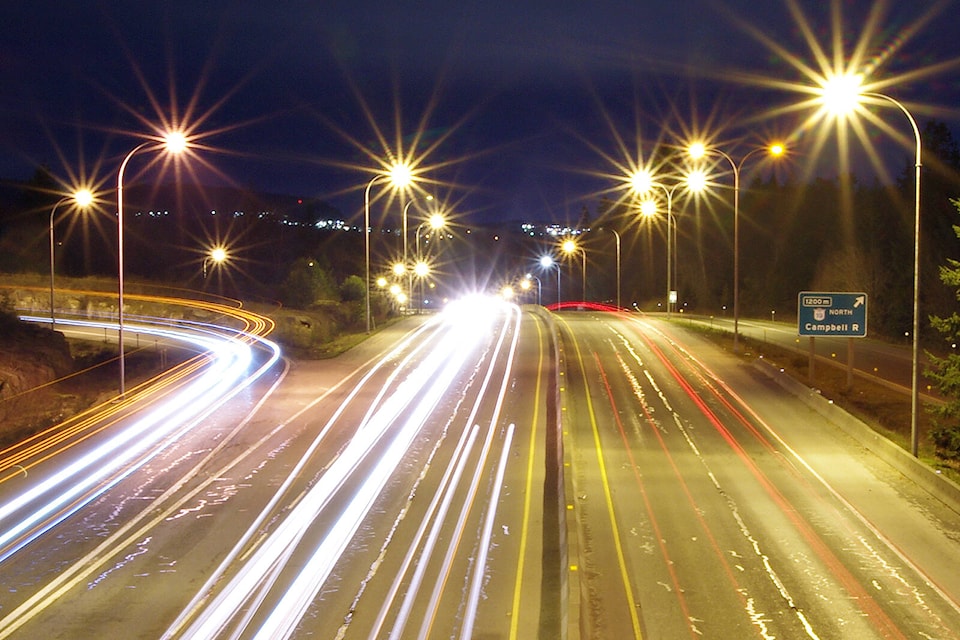Steps are being taken to illuminate a path toward minimizing light pollution over the Regional District of Nanaimo.
At an RDN board meeting Feb. 8, directors unanimously passed a motion by Leanne Salter, director for Coombs and Errington, to direct RDN staff to provide information on how to create a dark skies bylaw for her rural electoral area.
Salter’s motion targets LED street lighting Island communities are upgrading to from high- and low-pressure sodium lighting to take advantage of LED reliability, lower power consumption and cost savings.
“We have a lot of astronomers out here who certainly enjoy looking at the sky, recognizing that, in fact, there is a Milky Way up there…” Salter said. “The other piece is, certainly, the migration patterns and the impacts on wildlife that happens with regards to these lights.”
Salter said juvenile salmon are attracted to the LED lights at night and become vulnerable to predators and insects that were attracted to older lighting source types are not drawn to LED lights and are no longer available as food for bats.
“There’s a lot of reasons those lights don’t work and won’t work in our area, so we just want to go with dark skies at this time and try not to pollute the environment anymore than we already have,” Salter said.
Lehann Wallace, French Creek director, asked what the scope of gathering information for a dark skies bylaw would entail, what area would be covered by a bylaw and if there would be exceptions to upgrade lighting of highways or schools for public safety.
Kim Fowler, RDN manager of long-range planning, energy and sustainability, said several Canadian cities have dark skies bylaws and the RDN could follow examples of best practices. Any regional district regulations would not override provincial jurisdictional authority to upgrade lighting for schools or highways.
Fowler also said the RDN is working “in concert” with the City of Nanaimo on light pollution. The ReImagine Nanaimo master planning draft policies include taking measures to balance the city’s lighting needs and preserve dark skies.
The International Dark-Sky Association lays out principles for parks and communities to follow. The association works to promote responsible lighting policies and public education to encourage parks, communities and protected areas worldwide to preserve and protect dark sites. As of earlier this year, there were 195 certified International Dark-Sky Places.
Nanaimo director Ben Geselbracht supports the dark skies motion and said in an e-mail a greater degree of attention needs to be paid to lighting locations, intensities and light spectrum to minimize negative impacts while retaining necessary benefits. He said the city has received complaints about Nanaimo’s new LED street lighting.
“The recent hydro light upgrade was an example where that higher degree of intentionality was missing, where light intensities were chosen that were not really necessary, in my opinion, with the result of disrupting the sleep of some people or ability to focus,” he said.
“At the City of Nanaimo we are considering some policies around preserving dark skies where they exist so that the environment can follow its more natural pattern and people can enjoy the stars. In lit areas, city policy is being developed to have a more balanced and intentional approach around lighting.”
Nanaimo director Sheryl Armstrong said she has read a number of reports and warnings about the effects of LED lights from medical associations in the U.S. and Europe.
“When you’re starting to get the major medical associations talking about the negative health consequences and also the wildlife associations, I think it’s really important that we start looking at it,” Armstrong said at the meeting.
Numerous scientific studies dating back decades have been conducted on the impacts on human and environmental health from all artificial light sources. Detrimental effects don’t solely arise from LED light emissions, but one certainty is that as cities grow, light pollution worsens.
Chris Boar, Nanaimo Astronomy Society president, said in a phone interview that the organization’s members are keenly aware of the effects of light pollution from development.
Society members no longer use Westwood Lake Park for observations requiring dark skies because of light spillover from nearby residential developments and the society is working with the city’s parks and rec department to move its observation area to East Wellington Park.
“Part of that plan … is a designated area that we can observe from and do public outreach,” Boar said.
He said most nearby dark sky areas lie within gated private lands and are not accessible. Increasing light pollution, Boar said, is challenging amateur astronomers everywhere.
“If you really want to see dark skies you have to head out west,” Boar said.
READ ALSO: Regional District of Nanaimo board wants to learn more about creating dark skies bylaw
photos@nanaimobulletin.com
Like us on Facebook and follow us on Twitter
